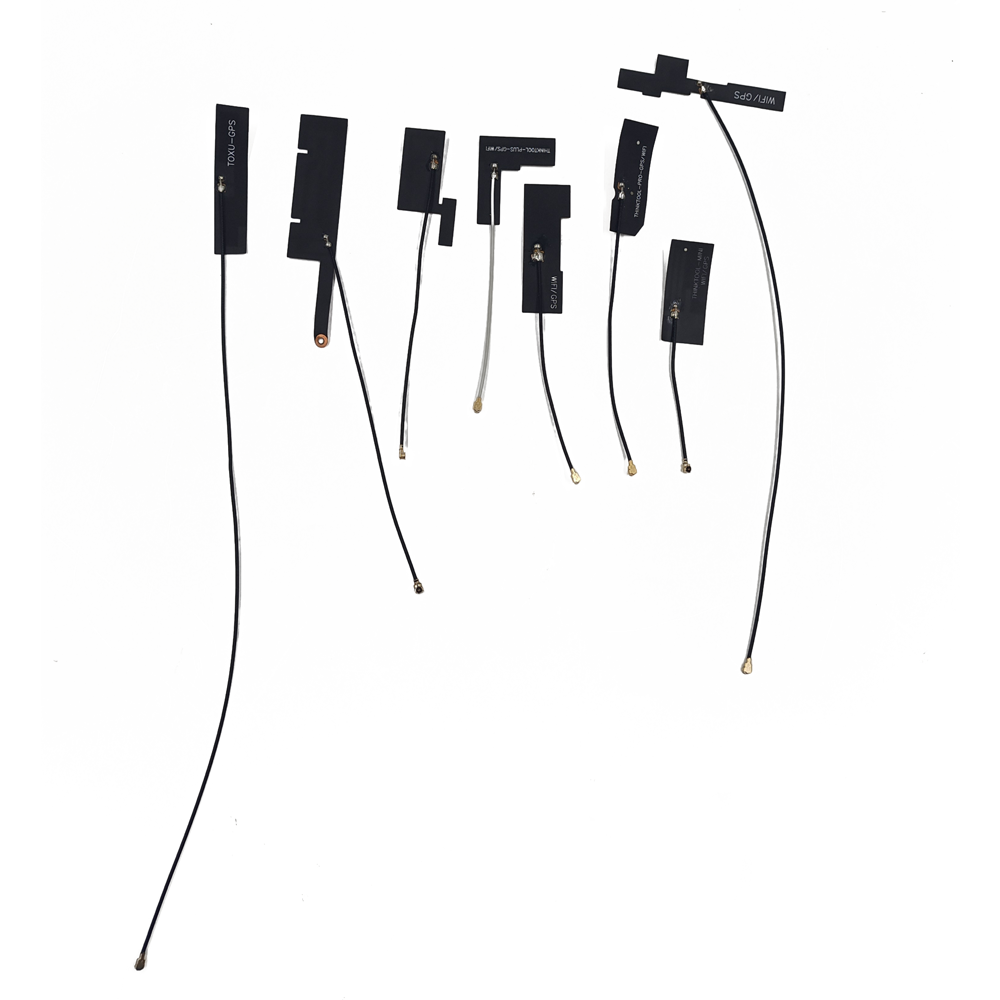Overview
1.1 Definition and Core Functionality
An internal GNSS (Global Navigation Satellite System) antenna for vehicle tracking systems is a compact, embedded component designed to receive satellite signals (GPS, GLONASS, Galileo, BeiDou, etc.) to determine a vehicle’s precise location, speed, and heading. Unlike external antennas, which are mounted on the vehicle’s roof or exterior, internal antennas are integrated into the vehicle’s dashboard, infotainment system, or telematics control unit (TCU), offering a seamless and discreet solution for fleet management, asset tracking, and connected vehicle applications.
These antennas are engineered to operate in challenging environments where signal obstructions (e.g., urban canyons, tunnels, dense foliage) and multipath interference (signal reflections off buildings or vehicles) are common. Their performance directly impacts the accuracy and reliability of vehicle tracking systems, which are critical for applications such as logistics optimization, theft prevention, pay-as-you-drive insurance, and autonomous navigation.
1.2 Market Drivers and Industry Trends
The global vehicle tracking market is projected to grow at a CAGR of 12.5% from 2025 to 2030, driven by:
Rising demand for fleet management solutions in logistics, transportation, and delivery services.
Government mandates for commercial vehicle tracking (e.g., ELD regulations in the U.S.).
Advancements in connected car technologies (V2X, 5G, and IoT integration).
Increasing adoption of electric vehicles (EVs) requiring real-time battery monitoring and location tracking.
Internal GNss antennas are gaining traction due to their space efficiency, cost-effectiveness, and aesthetic appeal compared to bulky external alternatives. Key trends include:
Multi-band and multi-constellation support (GPS L1/L5, Galileo E1/E5, BeiDou B1/B2) for improved accuracy and redundancy.
Integration with 4G/5G and Wi-Fi antennas for unified telematics solutions.
Miniaturization (dimensions <50 mm × 50 mm) to fit into smart mirrors, shark-fin assemblies, or behind-the-dashboard modules.
1.3 Key Players and Product Landscape
Leading manufacturers of internal GNss antennas for vehicle tracking include:
u-blox: ANN series (e.g., ANN-MB1) with L1/L2/L5 support for high-precision applications.
Tallysman: TW2710 (L1/L5) and TW3882 (multi-band) for compact integration.
Taoglas: MAGNA series (e.g., MA.810) with low-profile designs for automotive-grade deployment.
Antenova: M200 series (e.g., M20045-A1) for ultra-compact tracking in two-wheelers and small vehicles.
These products typically offer IP67/IP69K ratings for dust and water resistance, -40°C to +85°C operating temperatures, and AEC-Q100 qualification for automotive reliability.
Design and Construction
2.1 Core Components of an Internal GNSS Antenna
An internal GNss antenna consists of the following key elements:
2.1.1 Antenna Element
Microstrip Patch Antenna: The most common design for internal antennas due to its low profile (<5 mm) and multi-band capability via stacked patches or reactive loading.
Planar Inverted-F Antenna (PIFA): Used in space-constrained applications for its compact size and tunability across L1/L2 bands.
Helical Antenna: Rare in internal designs but occasionally used for circular polarization in high-multipath environments.
2.1.2 Ground Plane and Matching Network
Ground Plane: The vehicle’s metal chassis or PCB acts as a reflector, enhancing radiation efficiency. The antenna’s performance is highly dependent on ground plane size and shape.
Matching Network: A combination of inductors and capacitors (LC circuits) optimizes impedance matching (typically 50 Ω) to minimize signal reflection and maximize power transfer.
2.1.3 Low-Noise Amplifier (LNA)
Function: Amplifies weak satellite signals (−160 dBm) before downconversion, improving the signal-to-noise ratio (SNR).
Multi-Band LNAs: Modern designs integrate band-pass filters to isolate L1, L2, L5, etc., reducing inter-frequency interference.
Noise Figure: Typically <2 dB to preserve weak GNSS signals in urban environments.
2.1.4 Radome and Enclosure
Material: ABS plastic or polycarbonate for lightweight, durable housing.
Coating: Anti-UV and anti-scratch treatments for long-term outdoor exposure.
Mounting: SMT (Surface-Mount Technology) for PCB integration or adhesive mounting for dashboard placement.
2.2 Material Selection and Manufacturing
Dielectric Substrate: Rogers RT/duroid 5880 (εr = 2.2) or FR4 (εr = 4.4) for cost-effective patch antennas.
Conductive Layers: Copper or silver plating for low-loss RF paths.
LNA Components: GaAs pHEMT transistors for low-noise, high-linearity amplification.
Manufacturing Tolerances:
Phase Center Stability (PCS): Must be <2 mm across all frequencies to avoid positional errors during vehicle maneuvers.
Antenna Efficiency: >70% to ensure reliable signal reception in challenging environments.
2.3 Integration Challenges
Space Constraints: Internal antennas must fit within tight spaces (e.g., behind the rearview mirror or inside the TCU).
EMI/EMC Compliance: Must coexist with 4G/5G, Wi-Fi, and CAN bus signals without interference.
Thermal Management: LNAs generate heat, requiring thermal vias or heat sinks in high-temperature environments.
Working Principles
3.1 Signal Reception and Processing
Satellite Signal Capture:
The antenna receives L-band signals (1–2 GHz) from GNSS satellites, carrying navigation data (ephemeris, clock corrections) and carrier-phase information.
Multipath Mitigation:
Right-Hand Circular Polarization (RHCP) rejects left-handed reflections from buildings or vehicles.
Advanced antennas use choke rings or metamaterial structures to suppress ground-reflected signals.
LNA Amplification:
Weak signals are amplified (30–40 dB gain) while minimizing noise introduction.
Downconversion and Digitization:
The receiver converts RF signals to baseband for processing (e.g., correlation with satellite code/phase).
3.2 Multi-Band and Multi-Constellation Operation
Dual-Frequency (L1/L2) Advantages:
Corrects ionospheric delays, reducing positioning errors from ~5 m (single-frequency) to <1 m.
Triple-Frequency (L1/L2/L5) Benefits:
Enables RTK (Real-Time Kinematic) positioning with centimeter-level accuracy for autonomous vehicles.
Multi-Constellation Support:
Combining GPS, GLONASS, Galileo, and BeiDou increases the number of visible satellites, improving availability in urban canyons.
3.3 Positioning Algorithms
Least Squares Estimation: Basic method for solving pseudorange equations.
Kalman Filtering: Fuses GNSS data with odometer/IMU measurements for smoother trajectory tracking.
Machine Learning-Based Correction: AI models predict and mitigate multipath errors in real time.
Advantages and Challenges
-
4.1 Key Advantages
Aesthetic and Space Efficiency:
No external protrusions, improving vehicle design flexibility.
Cost-Effectiveness:
Lower installation and maintenance costs compared to external antennas.
Vandalism/Theft Resistance:
Internal placement reduces the risk of antenna tampering or removal.
Environmental Robustness:
Protected from dust, water, and extreme temperatures (IP67+ ratings).
4.2 Technical Challenges
Signal Attenuation:
Vehicle body materials (metal, glass) can block or reflect GNSS signals, requiring careful antenna placement.
Multipath Interference:
Urban environments cause signal reflections, degrading accuracy.
Thermal Constraints:
High-temperature operation (e.g., near engines) can detune antenna performance.
4.3 Operational Limitations
Limited Sky View:
Parking garages or dense urban areas may reduce satellite visibility.
Latency in High-Speed Scenarios:
GNSS updates at 1 Hz may lag in vehicles moving >100 km/h.
Applications and Future Trends
-
5.1 Current Applications
Fleet Management:
Real-time tracking of trucks, buses, and delivery vans for route optimization and fuel savings.
Usage-Based Insurance (UBI):
Telematics devices with GNSS antennas monitor driving behavior (speed, braking) for personalized premiums.
Vehicle Theft Recovery:
Geofencing and real-time alerts help recover stolen assets.
Autonomous Navigation:
High-precision GNSS enables Level 2+ autonomy in passenger cars and commercial vehicles.
5.2 Emerging Trends
Integration with 5G and V2X:
Combined GNSS/5G antennas support vehicle-to-infrastructure (V2I) communication for smart traffic management.
AI-Powered Multipath Mitigation:
Neural networks analyze signal patterns to dynamically suppress reflections.
LEO Satellite Augmentation:
Companies like SpaceX’s Starlink plan to integrate LEO signals for faster RTK convergence (<1 second).
Solid-State Antennas:
MEMS-based tunable antennas adapt to multiple frequency bands without mechanical components.
5.3 Market Projections
The internal GNSS antenna market is expected to grow at a CAGR of 14.2% from 2025 to 2030, driven by autonomous vehicles, smart cities, and EV adoption. By 2030, multi-band, multi-constellation antennas will dominate the high-end segment, while cost-optimized single-band solutions will serve budget-conscious applications.
Conclusion
Internal GNSS antennas are revolutionizing vehicle tracking systems by offering compact, reliable, and high-performance positioning in a discreet form factor. Their ability to integrate with multi-constellation GNSS, 5G, and AI-driven correction algorithms makes them indispensable for modern fleet management, autonomous navigation, and connected car ecosystems.
While challenges like signal attenuation and multipath interference persist, ongoing innovations in miniaturization, solid-state tuning, and LEO satellite integration are expanding their applicability across vehicle segments. As the automotive industry transitions toward full electrification and autonomy, internal GNSS antennas will remain a cornerstone of safe, efficient, and intelligent transportation systems—ushering in a new era of mobility.




































































 Language
Language
 En
En Cn
Cn Korean
Korean

 Home >
Home > 







 18665803017 (Macro)
18665803017 (Macro)













